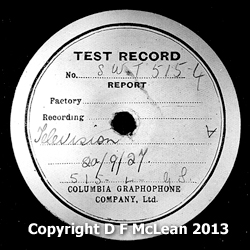Surviving Discs

SWT515-4 label
The Phonovision discs are all similar indicating they come from a common source. They are all single-sided pressings (two copies of RWT620-11 exist) and resemble 10-inch diameter 78rpm wax audio discs. each lasting about 3 minutes. The label from the earliest recording is shown on the left. Two more of the five discs have a label just like this. The label is a standard ‘Test Record’ label from the Columbia Graphophone Company complete with date and catalogue number. The catalogue information for all five of the discs is shown below together with a 14 second extract. (These audio clips are from my original transfers made between 1982 and 1987. In 1996 all but one of the Phonovision discs were archivally transferred by Symposium Records for the Science Museum.)
| Catalogue Number | Audio | Date | Comment |
|---|---|---|---|
| SWT515-4 |
Audio clip: Adobe Flash Player (version 9 or above) is required to play this audio clip. Download the latest version here. You also need to have JavaScript enabled in your browser. |
20-Sep-1927 | Dummy Head with large speed fluctuations.
This was Ben Clapp’s disc, believed to have been used as a tuning signal in late 1927 during tests leading to the event of witnessed Transatlantic TV in Feb 1928. |
| RWT620-4 |
Audio clip: Adobe Flash Player (version 9 or above) is required to play this audio clip. Download the latest version here. You also need to have JavaScript enabled in your browser. |
10-Jan-1928 | Man’s Head in Motion marred by over-modulation |
| RWT620-6 |
Audio clip: Adobe Flash Player (version 9 or above) is required to play this audio clip. Download the latest version here. You also need to have JavaScript enabled in your browser. |
no date | Man’s Head in Motion marred by amplifier resonance |
| RWT620-11 |
Audio clip: Adobe Flash Player (version 9 or above) is required to play this audio clip. Download the latest version here. You also need to have JavaScript enabled in your browser. |
10-Jan-1928 | Man’s Head in Motion |
| RWT115-3 |
Audio clip: Adobe Flash Player (version 9 or above) is required to play this audio clip. Download the latest version here. You also need to have JavaScript enabled in your browser. |
28-Mar-1928 | ‘Miss Pounsford’ with fast timebase resonance |
The catalogue number appears to act as a reference number to a particular recording session. Since the catalogue numbers of the two discs dated 10-Jan-1928 differ only in the last number, this may well indicate the ‘take’ in the recording session.
The dates on the labels are assumed to be genuine recording or pressing dates. A photo of another pressing of the disc dated 28th March 1928 appears in ‘Television’ magazine July 1928 supporting the genuine nature of the disc dates.
 When you look at the discs there is the pattern caused by the video signal being synchronised to the rotation of the disc. This radial pattern is reminiscent of a CAV Laserdisc. It does not appear on the subsequent Major Radiovision or Silvatone recording as Phonovision uniquely was planned to have synchronisation of the picture from the disc itself.
When you look at the discs there is the pattern caused by the video signal being synchronised to the rotation of the disc. This radial pattern is reminiscent of a CAV Laserdisc. It does not appear on the subsequent Major Radiovision or Silvatone recording as Phonovision uniquely was planned to have synchronisation of the picture from the disc itself.